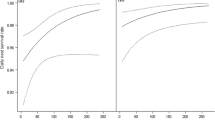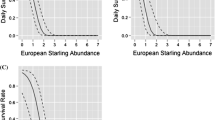Summary
Red-winged blackbirds, Agelaius phoeniceus, breed in marshes in high densities and their nests are frequently clumped. Because predation is consistently the most important cause of redwing nesting mortality, high densities of breeding individuals could be an anti-predation adaptation. In our study site predation by marsh wrens, Cistothorus palustris, was the main cause of redwing nesting losses. In situations when marsh wrens were near, predation rates on redwing nests decreased with increasing female density. Group life could reduce predation because of improved nest defense, selfish herd effects, or predator dilution effects. We differentiated between these possibilities by introducing experimental colonies consisting of 3, 6, and 9 artificial nests near and away from active redwing nests. The experimental colonies near active nests suffered less predation, but predation rates were not correlated with colony size or a nest's location within the colony. Therefore, the advantage of group life in this population is probably mutual nest protection.
Similar content being viewed by others
References
Altmann SA, Wagner SS, Lenington S (1977) On the evolution of polygyny. Behav Ecol Sociobiol 2:397–410
Bump SR (1983) Yellow-headed black bird nest defense: aggressive responses to marsh wrens. Unpublished M Sc thesis, Utah State University, Logan, Utah
Burt De Vere E (1970) Habitat selection and species interactions of some marsh passerines. M Sc thesis, Iowa State University, Ames, Iowa
Caccamise DF (1976) Nesting mortality in the red-winged blackbird. Auk 93:517–534
Case NA, Hewitt OH (1963) Nesting and productivity of the Red-winged Blackbrid in relation to habitat. The Living Bird, Second Annual of the Cornell Laboratory of Ornithology, pp 7–20
Crook JH (1964) The evolution of social organization and visual communication in the weaver birds (Ploceinae). Behaviour Suppl 10
Curio EB (1978) The adaptive significance of avian mobbing. Z Tierpsychol 48:175–183
Goddard SV, Board VV (1967) Reproductive success of red-winged blackbirds in north central Oklahoma. Wilson Bull 79:283–289
Hamilton WD (1971) Geometry for the selfish herd. J Theor Biol 31:295–311
Holling CS (1959) Some characteristics of simple types of predation and parasitism. Can Entomol 91:385–398
Holm CH (1973) Breeding sex ratios, territoriality, and reproductive success in the red-winged blackbird (Agelaius phoeniceus). Ecology 54:356–365
Howard RA (1977) Habitat structure, polygyny, and the evolution of upland nesting in red-winged blackbirds (Agelaius phoeniceus). Ph D Dissertation, Cornell University, Ithacy, New York
Kruuk H (1964) Predators and anti-predator behaviour of the black-headed gull (Larus ridibundus). Behaviour Suppl 11:1–129
Lack D (1968) Ecological adaptations for breeding in birds. Methuen, London
Lenington SG (1980) Female choice and polygyny in red-winged blackbirds. Anim Behav 28:347–361
Mayr E (1941) Red-wing observations of 1940. Proc Linn Soc NY, 52–53:75–83
Nero RW (1956) A behaviour study of the red-winged blackbird. II. Territoriality. Wilson Bull 68:129–150
Orians GH (1961) The ecology of blackbird (Agelaius) social systems Ecol Monogr 31:285–312
Orians GH (1969) On the evolution of mating systems in birds and mammals. Am Nat 103: 589–603
Orians GH (1980) Some adaptations of marsh nesting blackbirds. Princeton University Press, Princeton
Orians GH, Willson MF (1964) Interspecific territories of birds. Ecology 17:736–745
Picman J (1977) Destruction of eggs by the Long-billed Marsh Wren (Telmatodytes palustris palustris). Can J Zool 55:1914–1920
Picman J (1980a) Impact of marsh wrens on reproductive strategy of red-winged blackbirds. Can J Zool 58:337–350
Picman J (1980b) Behavioral interactions between red-winged blackbirds and long-billed marsh wrens and their role in the evolution of the redwing polygynous mating system. Unpublished Ph D thesis, University of British Columbia, Vancouver, BC
Picman J (1983) Aggression by red-winged blackbirds towards marsh wrens. Can J Zool 61:1896–1899
Picman J (1984) Experimental study on the role of intra-and inter-specific competition in the evolution of nest-destroying behavior in marsh wrens. Can J Zool 62:2353–2356
Picman J (1987) An inexpensive camera setup for the study of egg predation at artificial nests. J Field Ornithol (in press)
Pulliam HR (1973) On the advantages of flocking. J Theor Biol 38:419–422
Pulliam HR, Caraco T (1984) Living in groups: is there and optimal group size? In: Krebs JR, Davies NB (eds) Behavioural ecology; An evolutionary approach. Sinauer, Sunderland, Mass, pp 122–147
Ricklefs RE (1969) An analysis of nesting mortality in birds. Smiths, Contrib Zool 9:1–48
Ritschel SE (1985) Breeding ecology of the red-winged blackbird (Agelaius phoeniceus); tests of models of polygyny. Unpublished Ph D thesis, University of California, Irvine, Calif
Robertson RJ (1972) Optimal niche space of the red-winged blackbird (Agelaius phoeniceus). I. Nesting success in marsh and upland habitat. Can J Zool 50:247–263
Runyan CS (1979) Comparative habitats of, and competition between, the long-billed marsh wren and the red-winged blackbird at Pitt Meadows, British Columbia. Unpublished M Sc thesis, University of British Columbia, Vancouver, BC
Searcy WA (1979) Female choice of mates: a general model for birds and its application to red-winged blackbirds (Agelaius phoeniceus). Am Nat 114: 77–100
Smith HM (1943) Size of breeding populations in relation to egg-laying and reproductive success in the eastern red-wing (Agelaius p phoeniceus). Ecology 24:183–207
Verner J (1975) Interspecific aggression between yellow-headed blackbirds and long-billed marsh wrens. Condor 77:329–331
Verner J, Willson MF (1966) The influence of habitats on mating systems of North American passerine birds. Ecology 47:143–147
Weatherhead PJ, Robertson RJ (1977) Harem size, territory quality, and reproductive success in the red-winged blackbird (Agelaius phoeniceus). Can J Zool 55:1261–1267
Weatherhead PJ, Robertson RJ (1979) Offspring quality and the polygyny threshold. “The sexy son hypothesis”. Am Nat 113:201–208
Wittenberger JF (1976) The ecological factors selecting for polygyny in altricial birds. Am Nat 110:779–799
Wittenberger JF (1979) The evolution of mating systems in birds and mammals. In: Marler P, Vandenbergh J (eds) Handbook of behavioral neurobiology: social behavior and communication. Plenum, New York, pp 271–349
Author information
Authors and Affiliations
Rights and permissions
About this article
Cite this article
Picman, J., Leonard, M. & Horn, A. Antipredation role of clumped nesting by marsh-nesting red-winged blackbirds. Behav Ecol Sociobiol 22, 9–15 (1988). https://doi.org/10.1007/BF00395693
Received:
Accepted:
Issue Date:
DOI: https://doi.org/10.1007/BF00395693




